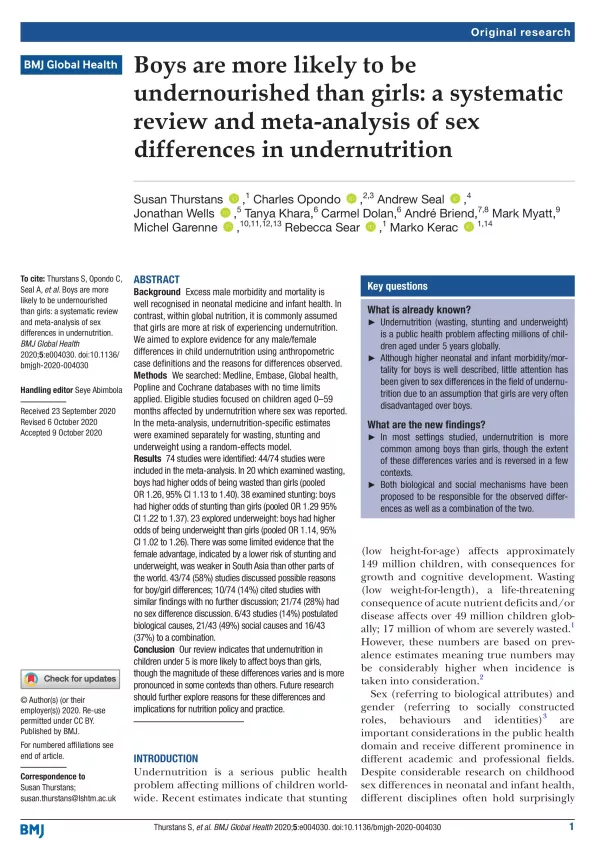Boys are more likely to be undernourished than girls: a systematic review and meta-analysis of sex differences in undernutrition
Publication details
Abstract
Background
Excess male morbidity and mortality is well recognised in neonatal medicine and infant health. In contrast, within global nutrition, it is commonly assumed that girls are more at risk of experiencing undernutrition. We aimed to explore evidence for any male/female differences in child undernutrition using anthropometric case definitions and the reasons for differences observed.
Methods
We searched: Medline, Embase, Global health, Popline and Cochrane databases with no time limits applied. Eligible studies focused on children aged 0-59 months affected by undernutrition where sex was reported. In the meta-analysis, undernutrition-specific estimates were examined separately for wasting, stunting and underweight using a random-effects model.
Results
74 studies were identified: 44/74 studies were included in the meta-analysis. In 20 which examined wasting, boys had higher odds of being wasted than girls (pooled OR 1.26, 95% CI 1.13 to 1.40). 38 examined stunting: boys had higher odds of stunting than girls (pooled OR 1.29 95% CI 1.22 to 1.37). 23 explored underweight: boys had higher odds of being underweight than girls (pooled OR 1.14, 95% CI 1.02 to 1.26). There was some limited evidence that the female advantage, indicated by a lower risk of stunting and underweight, was weaker in South Asia than other parts of the world. 43/74 (58%) studies discussed possible reasons for boy/girl differences; 10/74 (14%) cited studies with similar findings with no further discussion; 21/74 (28%) had no sex difference discussion. 6/43 studies (14%) postulated biological causes, 21/43 (49%) social causes and 16/43 (37%) to a combination.
Conclusion
Our review indicates that undernutrition in children under 5 is more likely to affect boys than girls, though the magnitude of these differences varies and is more pronounced in some contexts than others. Future research should further explore reasons for these differences and implications for nutrition policy and practice.

Cite this publication
Reference this page
Thurstans S, Opondo C, Seal A, et al Boys are more likely to be undernourished than girls: a systematic review and meta-analysis of sex differences in undernutrition BMJ Global Health 2020;5:e004030.